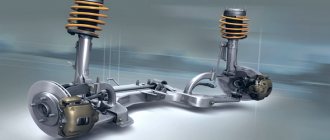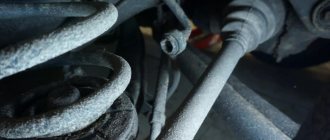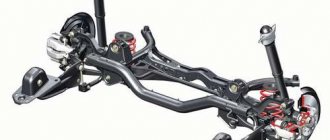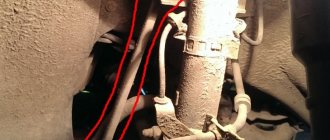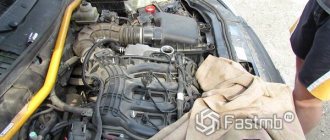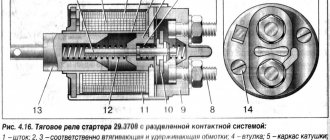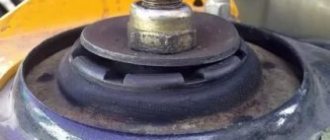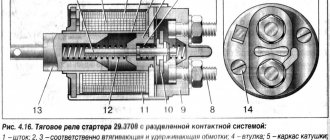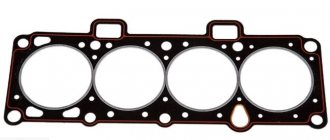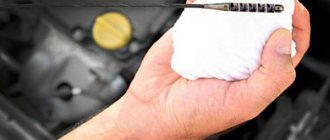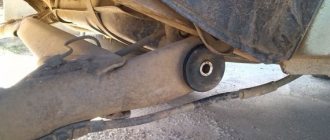Purpose of stabilizer struts
When designing suspension, car designers look for a compromise between comfort and road stability. Excessive rigidity adds safety, but turns the car into a vibration tester. Too soft, comfortable suspension leads to dangerous rolls when entering a turn.
Stabilizers are designed to combat this phenomenon. The device is a spring beam that works in torsion. If one wheel is pressed against the body (frame), with the help of a stabilizer, the same force acts on the second wheel, compensating for the roll.
Operating principle of the anti-roll bar
Racks are used to connect the suspension elements to the stabilizer (shown in red in the figure).
Mechanism design
This component is designed for a reliable and at the same time damping connection of the unsprung masses of the suspension (wheel, hub, steering knuckle) with the elastic part - the stabilizer beam. The common purpose of the stand is to provide a movable joint. In this case, the execution may be different:
- Ball joints. The most common scheme. Provides freedom to hinges in all directions. Example of ball joints
With this design, wear occurs the fastest, since the ball joints take on a load comparable to ¼ of the vehicle’s weight. The stand is constantly in motion, experiencing forces aimed at compression, tension and bending. It is used in suspensions where the components are arranged compactly and the stabilizer beam has a complex shape. Can be installed at an angle. Practically beyond repair or restoration. Earrings. A primitive but very reliable scheme. “Earring” type design
Elastic elements (rubber, polyurethane, silicone) are threaded onto the pin and secured with washers. Between the rubber bands are the eyes of the suspension arm and the stabilizer beam. Some freedom of movement is provided by the rubber stops themselves, but significant deviation from the vertical is impossible. This drawback does not allow the use of such racks in complex suspensions. The advantages include the ability to withstand significant loads and high maintainability. Silent blocks. Such a hinge has mobility in only one plane. Transverse deviations are allowed at a small angle. Option for silent blocks (detail circled in red)
The advantages include a longer service life (compared to ball joints) and relative maintainability. Disadvantage: limited use on complex suspension structures.
How to correctly identify wear and malfunction
A common sign of wear is looseness of the suspension and extraneous sounds. However, there are a number of signals that relate specifically to racks:
- Unusually high roll in corners.
- When driving over bumps in a long turn, the car tries to “jump off” the trajectory.
- Characteristic knocking noises in the suspension, especially during rebound, when the stabilizer joints are unloaded.
- When braking or accelerating, faint knocking sounds are heard in the suspension.
Operating a vehicle with damaged (worn) stabilizer links can result in loss of control and an accident, especially at high speeds. In addition, when the struts constantly knock, it distracts the driver from driving the car.
Wear of the hinges in the struts is a progressive malfunction. A slight play that appears, especially during movement under load, accelerates the development of the defect and leads to unpleasant consequences.
When the first signs of a malfunction appear, you should carry out diagnostics at a service center or independently check the condition of the racks in order to later restore them or remove and replace them.
Why are the anti-roll bars knocking on a BMW E34 (video)
How to determine when it’s time to change stabilizer links
In order to distribute the level of kinetic impact on the suspension, and not subject only its individual elements to special loads, stabilizer struts and bushings are used in any car. Read on to learn how to check the stabilizer struts, as well as how to properly carry out maintenance on the struts and bushings of the stabilizer system.
To get to the stabilizer struts, you will have to remove the wheel.
Stabilizer struts, as a rule, are located in different axes of the car, on both axles, and in good condition increase the stability of the vehicle (especially when performing any maneuvers).
Simply put, it is this complex design that prevents you from entering a full roll during a turn, or a lateral roll in the event of a rollover. This is the link between the car's suspension and the anti-roll bar.
By themselves, these parts are not too expensive, but their functional significance for the car is extremely high. In technical terms, these structures are not “picky” about constant maintenance and are easily amenable to preventive measures.
However, malfunctions that arise, even on a small scale, can cause a lot of problems for drivers.
It is important to prevent any malfunctions associated with racks at the initial stage of occurrence in order to prevent the occurrence of emergency situations
How to check stabilizer links
From Karamzin’s popular poem we remember that “nothing lasts forever,” including stabilizer struts. Like any other detail, their design is subject to the destructive effects of time mixed with external factors.
The more off-road, the worse the quality and the more time spent on overcoming roads, the faster the stabilizer struts wear out and deteriorate.
A reasonable question arises: “How to check the stabilizer links?” and how can a person without an impressive amount of mechanical knowledge or extensive experience in vehicle repair do this?
Advice
It should be remembered that a basic check of the condition of the stabilizer struts and bushings is carried out during the annual vehicle maintenance. Experienced mechanics know where, what and how to look for high-quality diagnostics.
If you have any doubts about such a service, or you encounter problems and want to make sure they exist, you can use a very easy and independent express check of the stabilizer struts (if you don’t know how to check the stabilizer bushings, this method is also perfect ).
First you need to remove the wheel. When the wheel arch is free, in order to get to the rack, you need to turn the steering wheel as much as possible in any direction. Take the “bare” stance with your hand in the middle third and swing it from side to side. If there is a problem, looseness and “play” will be observed.
The stabilizer bushing also requires inspection and timely replacement
The main possible malfunctions of the stabilizer struts
We have already dealt with the possible type of diagnostic measures that can help us identify a malfunction before an unexpected emergency occurs. But what situations can arise, and what are the most important signs of a malfunction of the stabilizer struts that await us during trips. The most important are considered to be:
- instability and roll of the car (especially when making sharp maneuvers);
- the car sways at the slightest turn of the steering wheel;
- on an uneven road surface, a sound is heard in the suspension;
- car swerving with the steering wheel lowered;
- “yaw” of the car when braking.
If you have at least one of these conditions, do not delay with the express diagnosis, which we described just above.
If you are convinced that the racks or bushings are damaged, and when checking, they observe play or wobbling, such parts must be replaced with serviceable ones.
After all, struts and bushings are considered “consumable materials,” which means you should be smart about replacing them in a timely manner.
Stabilizer link prevention
Depending on the car model, the stabilization system may differ in structure and components of its design. Some, in the presence of the first errors in operation (creaking, slight play), are accepted to extend the service of existing consumables.
To find out how to lubricate the stabilizer links, you should ask the technical support of your car manufacturer, since this information is individual for each model.
As a rule, home repair specialists use silicone-based lubricant for better movement of stabilizer bushings.
How to check: diagnostics at home
Attention! The general rule for diagnosing suspensions is to look for faults in an unloaded state. The hinges, compressed under the weight of the car, may not show any play.
An assistant may be needed to carry out the diagnosis.
Necessary tools for performance testing
- Jack. Designed for lifting and suspension manipulation purposes only. It is dangerous to carry out work when the car is supported only by a jack!
- Support stands for the bottom (frame).
- Wheel chocks.
- A pry bar or a small crowbar.
- It is advisable to have a car enthusiast's stethoscope. Without the vehicle moving, knocks in the suspension are not so pronounced; sometimes they can only be detected with the help of a stethoscope.
Using a car stethoscope, you can listen not only to suspension malfunctions, but also to engine noise.
How to check the serviceability of parts
- Inspect the geometry of the racks. Abnormal bends are a sign of a malfunction, and driving on such ones is not recommended.
- Carefully examine the condition of the front hinges. Torn ball boots, cracks in silent blocks or rubber bushings indicate critical wear.
- While under the bottom of the car (in the pit of the garage), ask an assistant to rock the body with his hands. Obvious knocking noises will be noticeable, and it will not be difficult to find out the malfunction.
- Unload the suspension. To do this, lift the car with a jack and place it on support stands. The wheels should not leave the ground. Both sides should be lifted, otherwise the elastic beam will twist. Pull the racks with a sharp movement - the play will be noticeable. Use a stethoscope for an accurate diagnosis.
Do-it-yourself restoration and repair (with photo)
Faulty racks should be dismantled. This procedure is performed with a standard tool. You may need a ball joint remover. Depending on the design of the rack, it should be replaced or repaired.
- Ball joints are practically irreparable. There are repair mixtures that are injected into the hinge and, when hardened, eliminate the play. This method is questionable, the effect will be short-lived.
Advice! To prevent wear of the stabilizer ball joints, the boots should be checked regularly. If a crack or tear appears, the rubber should be replaced.
Earrings are the easiest option in terms of repair and restoration. Only rubber couplings are subject to wear; the strut stud can only be damaged in the event of a serious accident. All you need to do is purchase a rubber repair kit, disassemble the rack and install new elastic elements. They look something like this: The choice of bushing material depends on the driving style and the owner’s love for comfort
If you don’t have the necessary bushings, you can find suitable bushings in the car market that are suitable in diameter and thickness. It is important to remember that the rubber bands are designed for a certain weight of the car. The same applies to replacing material. Polyurethane has a longer service life, but is harder than rubber. You can lose in comfort. When replacing the support rubber bands, you should thoroughly clean the seat (eye). Sand and dirt contribute to wear. Silent blocks are somewhat more difficult to change, but independent repairs are still possible. Pressing silent blocks can also be done using homemade devices
If there are ready-made repair kits, that’s good. If not, choose the appropriate diameter. It is important not to make a mistake with the diameter of the hole in the metal bushing, otherwise the stand will hang on the support pin. Dismantling and pressing of the silent block can be done with a homemade press based on a jack.
You will need a hydraulic jack for this work.
Important! The installation of restored racks has its own peculiarities. Secure (but do not tighten) the mounting nuts and lower the vehicle to its normal position, then perform final tightening. More details about the installation are described here.
If the stabilizer struts are not suitable for repair, they should be replaced with new ones. You can read more about replacing stabilizer struts here.
Self-diagnosis and repair of stabilizer struts is not difficult for an experienced car enthusiast. By servicing your car, you not only save money. Familiarity with the design adds confidence during operation; you will not be taken by surprise on a long journey.
Source
Do-it-yourself replacement of stabilizer struts, instructions for use
To work you will need a standard set of tools, including:
• WD-40 or a similar product to facilitate the process of unscrewing stuck and rusted connections; • a spanner or open-end wrench of the appropriate size; • a hexagon; • a brush for cleaning metal parts; • a clamp and tool for fixing threads.
Before starting the operation to replace faulty stabilizer struts, it is necessary to jack up the front or rear of the car (depending on which suspension the repair will be carried out), having previously prevented the possibility of a rollback by activating the handbrake and placing stable stops under the wheels.
Attention! You need to hang both wheels of the same axle so that the suspension is in complete balance.• Then you need to clean the areas of the upcoming repair from dirt and dust, spray the fastenings with WD-40 spray.• Unscrew the stabilizer links; to do this, you need to secure the axle shaft from rotation using a hexagon and unscrew the stand itself.• Remove the old element, carefully place the new one in its place, install the bolts without tightening the locking nuts until they stop. It is best to use new fasteners for each replacement. Attention! The nuts should be tightened all the way at the moment when the car is removed from the jacks, that is, when the suspension reaches its natural position
• Remove the car from the jacked position and tighten the nuts to the end
Attention! The nuts should be tightened all the way at the moment when the car is removed from the jacks, that is, when the suspension reaches its natural position. • Remove the car from its suspension on the jacks and tighten the nuts to the end. After a few kilometers, it is recommended to tighten the nuts
After a few kilometers, it is recommended to tighten the nuts
• Remove the car from its suspension on the jacks and tighten the nuts to the end. After a few kilometers, it is recommended to tighten the nuts.
These instructions are suitable for replacing stabilizer links on the rear suspension. To perform work on the front, you will also need to place the car on two jacks, secure it from movement with the handbrake and stops under the wheels.
Next, secure the axle shaft against rotation with a hexagon and remove the nut. Remove the thrust washer and loosen the stem nut half a turn. Remove the brake calipers, release the struts from their mountings and replace them with a new part.
Note! Stabilizer struts should be changed in pairs, otherwise you will not get the desired result.
Knock of stabilizer struts: how to identify and eliminate it yourself
- Characteristic signs
- What is the danger
- What is needed for repair and diagnostics
- Repair procedure
- What's the result?
Hi all! The topic for our conversation today will be the knocking of stabilizer struts, which a large number of motorists have had to deal with.
It is extremely unpleasant when, during a trip, the car begins to make certain sounds that are uncharacteristic of a working car. This makes you nervous and worried.
It is fair to call the knocking of struts one of the most unpleasant. You need to understand why it appears, how to cope with it, and what it could potentially lead to if you ignore the symptoms.
Characteristic signs
As you know, stabilizers are necessary in order to adapt a vehicle to driving in different conditions and on different roads. The name itself suggests that these elements stabilize the behavior of the car.
To connect the front and rear stabilizers to the suspension elements, struts are used. This is the connecting link between the suspension and stabilizers.
But it happens that extraneous noise in the form of knocking begins to come from this link. This may apply to both the front and rear stabilizer struts.
If you notice a possible knocking sound from the stabilizer struts, since the sound emanating from there does not always indicate a breakdown of this particular unit, you need to look at additional characteristic signs.
What is the danger
Knowing how the knocking of stabilizer struts manifests itself, it is logical to ask what to do next.
It even happens that a new rack knocks, literally after replacement. This can be explained by incorrect installation, a problem in other components, or a banal factory defect.
It cannot be said that knocking struts is a characteristic problem of exclusively inexpensive cars such as Lada Vesta, Chevrolet Lacetti, Polo Sedan, etc. This happens on any car, since we are talking about consumables. Yes, the service life of the racks is impressive, but it is not eternal.
If a knock occurs from the stabilizer struts, it is strongly not recommended to continue driving.
However, not everyone understands why knocking is dangerous. Let's try to explain.
A stabilizer link that begins to fail and makes knocking noises reduces the quality of control, which can lead to an accident. At the same time, knocking sounds simply distract the driver.
A knocking sound indicates that the hinges inside the struts are gradually wearing out. Continuing to move, production will only progress. At first it’s just noise, then there are outright knocks, body roll and other signs.
Function of stabilizer struts and their service life
The struts act as a connecting element between the stabilizer and the suspension. They absorb the loads that arise when the car turns and thereby prevent body roll. Structurally, it is a metal rod with articulated movable joints at the ends. The hinges are covered with anthers on top.
If the stabilizer links are damaged, the car will lose control and may skid or overturn.
The service life of the struts, according to manufacturers, is about 100 thousand kilometers. But for Russia such figures are irrelevant. Even the most careful drivers feel the first signs of strut wear after traveling 50 thousand km from the moment of replacement, and if they are of poor quality, then sooner. There is no point in delaying the installation of new racks. This is dangerous both for the car’s suspension (repairing it will cost more than replacing the struts) and for the driver and passengers.
What is needed for repair and diagnostics
It is important to take into account that knocking of the racks can also occur when the elements are in working order. This is possible if the stabilizer has not been adjusted correctly. It is also important to correct such an oversight in a timely manner so that it does not turn into a full-fledged and serious breakdown.
Diagnostics and repairs are carried out with the vehicle raised. This is the only way to detect the backlash. Therefore, for work you should arm yourself with:
- jack;
- wheel shoes;
- frame stand;
- stethoscope;
- standard set of tools.
The latter tool will allow you to more accurately detect the source of the knocking, and make sure that the fault lies precisely with the stabilizer struts.
What to do if the stabilizer link starts knocking: is it possible to drive?
The main sign of a malfunction is the sound of the struts, while a number of additional signals are observed:
- constant body roll when turning;
- spontaneous change in the trajectory of the vehicle while driving over uneven surfaces;
- when driving, you can hear the stabilizer joints rattling;
- During acceleration or braking, the suspension feels loose.
If the stabilizer bar is knocking: is it possible to drive? This is the question that worries most car owners. Let us emphasize once again: it is strictly not recommended to operate a vehicle on which the stabilizer struts are damaged, since such a malfunction causes a decrease in controllability, and this can provoke a serious accident. In addition, the constant knocking of the suspension while driving distracts the driver all the time.
The deterioration of the hinges located inside the stabilizer struts is a progressive defect, since at the initial stage the malfunction does not manifest itself in anything, and then, as wear progresses, extraneous noise and body roll occur while driving. As soon as the first symptoms are noticed, you must immediately go to the nearest car service center to diagnose the condition of the suspension elements (in particular the stabilizer struts), or perform independent troubleshooting.
Important! To diagnose the condition of the suspension, it is necessary to lift the car on a lift, or jack it up on all sides, since under the weight of the vehicle it is not always possible to detect play in the hinges.
Can stabilizer struts make knocking noises when they are in good condition? Naturally, yes. The cause of extraneous noise is incorrect adjustment of the stabilizer elements, which must be eliminated without fail.
To carry out the diagnostic process, you may need the help of a friend and the following set of tools:
- jack - for lifting a vehicle and inspecting and repairing suspension parts. Please note that safety regulations prohibit performing any work when the car is jacked up without placing appropriate supports under its frame;
- shoes for fixing wheels;
- frame stands;
- It would be nice to have a car stethoscope, since when the suspension is unloaded, extraneous noise from its elements can only be heard with its help.
Repair procedure
Now directly about what the car owner has to do as part of diagnostics and repairs caused by knocking of the stabilizer struts on the vehicle.
The sequence of procedures will be approximately as follows:
- After raising the car using jacks or a lift, check the geometry of the struts. If it is broken, the machine cannot be operated;
- Inspect the front hinges. If there are defects in anthers, bushings or silent blocks, they need to be replaced;
- Rock the car to see where the sounds are coming from. But this can only be done in the inspection hole, and not by lifting the car on jacks;
- When checking the suspension, be sure to unload it and remove everything unnecessary from the car;
- If the racks are in good working order, there should be no play or noise when rocking and tugging the elements;
- If the racks fail, they will have to be dismantled. It's not that difficult, but it's worth arming yourself with a ball joint remover.
In most cases, stabilizer struts on cars are not suitable for repair. Therefore, the essence of the work being carried out comes down to replacing elements. Moreover, you can change them even in a garage, with your own hands.
You can watch the video for an example of replacing racks and highlight a lot of new things for yourself.
Rack repair
Many car owners do not recommend repairing the strut, since after restoration it can rarely last for a long time. Despite this, there are many ways to restore the functionality of your knuckles. One method is given below.
- Remove the boot.
- Clean out the old grease and add new one.
- Squeeze the joint in a vice in the direction shown in the photo.
An alternative repair option is given below.
- Remove the boot.
- Rinse with kerosene.
- Tap the body with a core.
A more complex method for repairing a rack is shown below.
- Drill the side of the hinge.
- Insert the grease fitting.
- Fill with lubricant.
If the rod breaks, there are also methods to solve the problem. If you have welding, you can use it to fasten the two ends together. An alternative is to cut threads and use special connectors.
What's the result?
A knock coming from the stabilizer struts is an unpleasant and potentially dangerous symptom.
Considering the design features of a car suspension, the noise coming from there is not always related specifically to this unit. To verify this or refute guesses, diagnostics are required.
One way or another, uncharacteristic noise always indicates the presence of certain problems with the vehicle. Eliminating them yourself, or seeking professional help, is up to each individual.
Have you ever encountered knocking noise from stabilizer struts? What was the reason and how did you get out of this situation?
Write your life stories in the comments.
Source
Signs of malfunctioning stabilizer struts
A breakdown of the anti-roll bar can cause the vehicle to lose control and lead to an accident. Therefore, it is important for a car owner to be able to identify a malfunction in time, as soon as its first symptoms appear.
A breakdown of the car's stabilizer bar leads to excessive roll. When driving straight on a flat road, the malfunction is unnoticeable, but any turning into a turn is accompanied by strong rolling.
Rolls at high speed are especially dangerous. The car may not stay on the intended trajectory and somersault. If excessive rolliness is detected, reduce speed and avoid unnecessary maneuvers.
How do you know when it's time to replace the stabilizer link?
How do you know when it's time to change your brake pads?
The main symptom of a faulty strut is a dull knock in the front of the car when driving on uneven roads. The noise appears precisely when driving over uneven surfaces. For example, along a cobblestone road.
On Lada Vesta, factory stabilizer struts often fail after 10-20 thousand kilometers. But the full working life of the part is also not long - 50-60 thousand km. Therefore, you need to periodically listen to the car while driving, especially if its mileage is more than 30-40 thousand km.
How to check the stabilizer link yourself?
You can check the part yourself, without special tools and knowledge.
If you look at the front wheel of the Lada Vesta, you will see a stabilizer strut immediately behind it. And you can reach it with your hand.
Checking instructions:
- Reach your hand over the wheel and feel for the strut.
- Press one of the hinges with your palm (for example, the top one).
- Use your other hand to rock the car slightly.
If the stand is loose, you will feel it with your hand. If the part is severely worn, a knocking noise may even occur. If there is no play or noise, then the rack is in good condition.
Thus, you need to check both hinges on the left and right sides. After this, you can already think about replacing parts.
If the rack is slightly damaged, then it may not have any play and only tap while driving. Then it will not be possible to identify the breakdown using this method. But this situation is extremely rare.
What are the dangers of driving with a faulty strut?
If the part is not replaced in time, it will no longer soften impacts while driving. Because of this, the car’s handling will deteriorate, and every unevenness in the road will be felt in the cabin.
Due to faulty struts, the load on other suspension elements that are not designed for this increases. Theoretically, this could lead to additional breakdowns. In practice, you can drive a car without stabilizer bars at all. But such driving can hardly be called comfortable and safe.
Rocking car
Failure of the anti-roll bar leads to excessive swaying of the car, which is observed during:
- trains over bumps;
- braking;
- occurrences turn;
- acceleration
If you do not pay attention to the rocking of the car, this may result in loss of control over it. As a result, the car will fly off the road or roll over.
In addition to the swaying of the car from the suspension side, there are other signs of a malfunction of the stabilizer link. The chassis becomes softer, and road surface unevenness is “swallowed” better. Due to the improvement in comfort with broken knuckles, many car owners recommend dismantling them even on fully functional cars.
The influence of stabilizer struts on movement
From all of the above features, we can freely say what the stabilizer struts influence. The driver must first of all understand how to behave when cornering and generally drive correctly.
Stabilizer struts affect the following points:
- movement of the vehicle in general;
- without them it is impossible to operate the machine;
- there is a risk of getting into an accident;
- constant noise.
Signs of malfunctioning stabilizer struts
If the struts are worn out, the car will not be able to protect itself from skidding, since the hinges at the ends will not perform their functions. The driver gradually begins to feel a less smooth movement, there will be a feeling of riding on an ironing board. It will subsequently seem so unstable that the car enthusiast will be afraid to get behind the wheel. Quickly worn-out parts are a sign of careless driving, and when the struts are almost worn out, you need to hold the steering wheel with even more confidence than when the struts were still in good condition.
In addition to all this, do not forget that they also connect the anti-roll bar to the suspension arm, so it’s simply not possible to drive without struts. They have a fairly low price on the market and, as a rule, one of these is enough for six months of driving. In any case, there must be a component that allows you to do what the anti-roll bar does.
Extraneous sounds
The most harmless symptoms of a faulty stabilizer bar link are extraneous sounds. The intensity of the noise depends on the speed and angle of rotation.
The ball joint struts make a lot of noise when driving over any uneven road surfaces. For example, moving speed bumps can indicate a malfunction of the knuckle. The sound will definitely come from the wheel arch only on the side on which the malfunction is present.
It is much more difficult to detect a breakdown of a rack whose design includes bushings. When such a spare part fails, it begins to creak and knock. The sound is quite quiet and cannot always be recognized while inside the car.
When should you change?
Racks need to be changed periodically. How often depends on your driving style. Some motorists are accustomed to driving along the road for their own pleasure, without noticing potholes, sharp turns, speed bumps, while others monitor the road more clearly, and accordingly, their racks last much longer.
Stabilizer link wear
But how can you determine if a stabilizer link is faulty? There are several methods that mechanics recommend, and many drivers have tried them. These methods are considered the most correct, they include:
- noise check;
- turning the steering wheel all the way;
- strong roll when turning;
- checking lubrication.
Car enthusiasts recommend using all methods in turn. To some extent, this list is also an algorithm for identifying a malfunction. If you try all four methods, the driver can find out for sure whether the struts need to be changed.
Rack Installation
Like many other important parts of a car, the stabilizer bar makes noise because it wants to, but cannot, perform its functions. It cannot be compared with anything - a kind of roar and grinding sound at the same time, which is noticeable precisely when cornering. The sharper the turn, the louder the noise. Most drivers check the malfunction in this way, since this is more likely not a method, but a sign of a breakdown.
Stabilizer link diagnostics
There is another popular method, but it is used only by those who have the opportunity to lift the car on a lift. To do this, you will need to turn the steering wheel all the way several times, at which time your friend should touch the rack and feel the vibrations. If you turn the steering wheel quickly, you can again hear noise from the pillar, only this time your friend will see where it’s coming from. If this is observed, the stand definitely needs to be changed.
Car skidding
Also, while driving, the driver may feel discomfort. Of course, it will be felt during all the same turns and bumps. Experienced drivers know that if it skids, there is a problem in stabilizing the movement, which means the struts need to be changed. In fact, this method never tells for sure, since the skid begins gradually and sometimes the driver simply does not notice the effect until he hears this very roar.
Removing the stabilizer link
You can also check the rack for malfunction by directly interfering with its structure. This is easy to do - first you need to remove the car stand. Then both hinges are untwisted at the ends. Each of the hinges is equipped with a boot that protects it from the accumulation of dirt rising from the road surface.
Stabilizer link boot
Under the boot there is lubricant placed there by the manufacturer. If the strut is in a faulty condition, under the boot there will no longer be grease, but dirt mixed with this very technical Vaseline. Drivers often do the tricky thing - they remove this mass under the boot and apply their own lubricant so as not to buy a new strut. You can use this spare part for a while longer.
Determining the malfunction of the stabilizer link
The presence of a malfunction in the stabilizer link should be determined by rocking the car from side to side in the transverse direction relative to the movement of the car. It is convenient to perform this operation together with an assistant. If the swinging occurs effortlessly and a characteristic knock is heard from the wheel arch, then there is a high probability of a malfunction of the stabilizer link.
- If a problem is suspected, check the condition of the rack using the method below.
- Turn the wheel as far as possible to the side until access to the rack opens.
- Take the domino with your hand.
- Shake the stand. The presence of backlash is unacceptable.
- While holding the knuckle with your hand, you need to ask an assistant to rock the car. There should not be any extraneous sounds coming from the rack. A good knuckle does not play.
If, when turning the wheel, access to the stabilizer link does not open, then the car should be placed in a viewing hole. In the future, the analysis of the condition of the knuckle is similar to the above instructions. The rear axle stabilizer struts are checked in the same way.
Replacing the front stabilizer strut of a Mazda 3 in a car service center
Replacing the mechanics of a car service center is carried out on a lift. Raise the car and remove the front wheels.
After dismantling the wheels, unscrew the bottom bolt holding the part. Be sure to use a second key to keep your finger from turning. In order to disconnect the rack, you need to lower the car, placing a stop under the suspension. Lower until the finger is free and can be easily removed. After this, you need to unscrew the bolt from the upper pin. They also hold it with a key, and try to unscrew it with the second. This doesn't always work out.
The new part is inspected for mechanical damage and only then installed in place. The second side is changed in a similar way.
When tightening the lower and upper nuts, be sure to hold the pin with a second wrench. This completes the replacement. Our experts recommend constantly monitoring the health of the system.
It is best to carry out diagnostics at a car service center. This way you will be sure of the location of the problem and its cause.
Visual inspection
A visual inspection of the stabilizer link can detect signs of malfunction of the stabilizer link. The key points to pay attention to when checking a domino are shown in the table below.
Table - Signs of malfunctioning knuckles that can be identified by visual inspection
| Fault criterion | Note |
| Mechanical damage to the rod | Most often there is a fracture at the weld joint of the strut. Deformations also occur, but they are much less common. |
| Rubber loses its original properties | As a result of natural aging and exposure to an aggressive external environment, rubber loses its elasticity and cracks and tears may appear on its surface. This phenomenon is typical for bushings and hinge boots. |
| Excessive wear | Most easily found on stabilizer links with bushings. The rubber wears away on one side, causing metal to come into contact with metal, which is the source of the characteristic knocking sound. |
Checking new racks
When purchasing new racks, they also need to be checked for functionality. This is due to the presence of a large number of defects and fakes on the market. The table below contains a list of criteria that you should pay attention to when checking the purchased spare part.
Table - Criteria for checking new stabilizer links
| Criteria to pay attention to | Note |
| Package | It is recommended to check all insignia against counterfeits using information from the manufacturer’s official website. This will help you avoid purchasing counterfeits. |
| Measure all lengths and thicknesses | Many budget manufacturers violate production technology, which leads to differences in sizes. By purchasing such a spare part, the car owner will not be able to install it in its original place and the rack will need to be modified. |
| Availability of lubrication | The durability of the strut joint directly depends on the amount of lubricant. Many manufacturers use very little lubricant, which sticks to the boot. Running the hinge “dry” quickly disables it. Therefore, after purchasing a new product, you should remove the cuff and add lubricant if necessary. |
Determining the malfunction by dismantling the rack
You can check the stabilizer link for malfunction by removing it from the car. This can be very difficult to do due to corrosion and sticking of threaded connections, so identifying problems with the knuckle by removing it from the machine is a last resort.
The lubrication should be checked on the dismantled rack. It should be in sufficient quantity and not contain any liquid or debris.
Before completely removing the stabilizer link from the car, it is recommended to carry out diagnostics by unscrewing only one fastener. The knuckle should be shaken from side to side. If a characteristic sound occurs, the car owner will know exactly which side of the rack has become unusable.
Source
